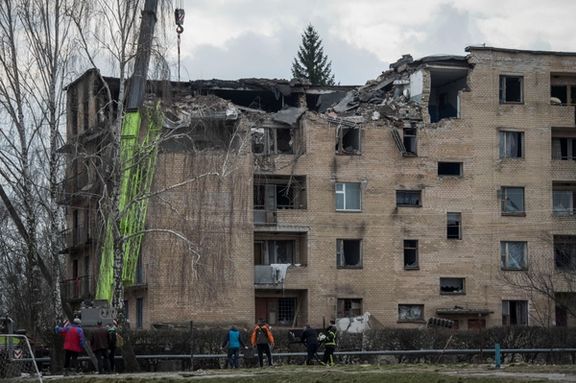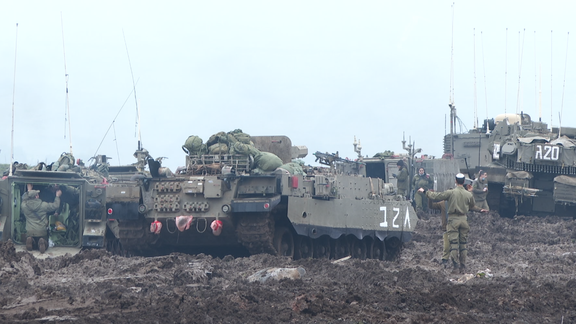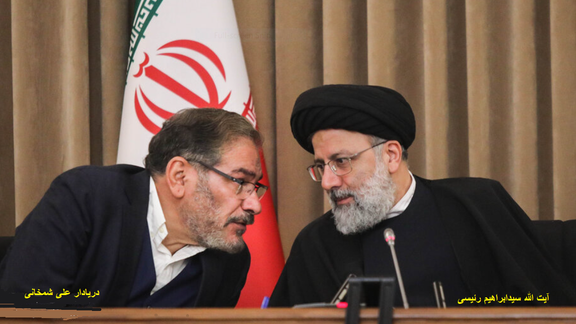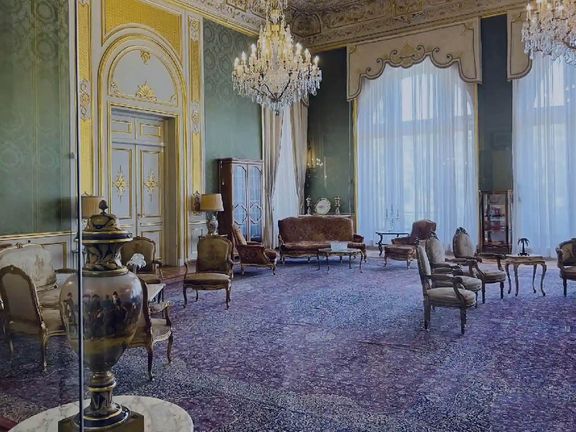Iran Unveils Latest Ballistic Missile

Iran unveiled the fourth generation of its Khorramshahr ballistic missile, called Kheibar, with a range of 2,000 kilometers.

Iran unveiled the fourth generation of its Khorramshahr ballistic missile, called Kheibar, with a range of 2,000 kilometers.
State media reported that the country successfully tested the ballistic missile on Thursday, two days after Israel's military chief raised the prospect of "action" against Tehran.
Lieutenant-General Herzi Halevi, chief of Israel's armed forces, warned: "Iran has advanced with uranium enrichment further than ever before ... There are negative developments on the horizon that could bring about (military) action.”
Iran, which has one of the biggest missile programs in the Middle East, says its missiles can reach Israel and US bases in the region.
Tehran has said it will continue to develop its "defensive" missile program despite opposition from the United States and European countries.
"Our message to Iran's enemies is that we will defend the country and its achievements. Our message to our friends is that we want to help regional stability," said Iranian Defense Minister Mohammadreza Ashtiani.
Iran claims its ballistic missiles are a deterrent and retaliatory force against the United States, Israel, and other potential regional adversaries.
Efforts to revive Tehran's 2015 nuclear deal have stalled since last September amid Western fears about Tehran's accelerating nuclear advances.
Iran's nuclear activities were restricted by the nuclear agreement, which Washington ditched in 2018, extending the time it would take for Tehran to produce nuclear material for a bomb. Iran denies pursuing nuclear weapons.

Ukraine said Thursday it had shot down all 36 Iranian-made drones launched by Russia in overnight attacks probably targeting critical infrastructure and military facilities.
President Volodymyr Zelenskyy said it had been an "uneasy night" but commended the work of air defenses.
"Continuing to terrorize Ukraine, the enemy used 36 Shahed (drones). None of them reached their target. Thanks to our air defense forces for the 100% result," he wrote on the Telegram messaging app.
Zelenskyy urged Iran on Wednesday to reconsider the supply of the killer drones to Russia in order to stop their slide into "the dark side of history."
Since last October, Moscow, which launched its full-scale invasion in February last year, has regularly sent waves of drones to attack targets in Ukraine. Although they are slow, drones are cheaper and more expendable than advanced missiles.
Some experts say that Russia's use of the Shahed drones, costing around $20,000 each, either is meant to confuse Ukrainian air defenses during missile attacks, or to force Kyiv to spend its expensive Western-supplies anti air missiles.
"The enemy likely aimed to attack critical infrastructure and military facilities in the western regions of the state," the Ukrainian air force said on Telegram.
It said Iran-made Shahed 136 and Shahed 131 drones had been used.
The head of Kyiv's military administration said the capital had come under attack by several waves of drones but that all had been shot down. He said it was the 12th attack on Kyiv this month.
Regional and military authorities in southern and western Ukraine reported shooting down drones.
Western powers have strongly objected to Iran's decision to arm Russia with the Kamikaze drones, and possibly other weapons and ammunition.
With reporting by Reuters

Ukrainian President Volodymyr Zelenskyy urged Iran Wednesday to reconsider the supply of killer drones to Russia in order to stop their slide into "the dark side of history."
Iranian-made Shahed drones supplied to Moscow have played a major role in Russia's attacks on cities and infrastructure, though Zelenskyy said Kyiv's air defenses were now skilled at downing them - about 900 of 1,160 aimed at Ukrainian targets.
"The simple question is this: what is your interest in being an accomplice to Russian terror?" Zelenskyy said in his nightly video address.
"What is the benefit to Iran of such cynical killing? By Russian hands, but with your weapons, your weapons...Your Shaheds, which terrorize Ukraine every night, mean only that the people of Iran are being driven deeper and deeper into the dark side of history."
Western powers have strongly objected to Iran's decision to arm Russia with the Kamikaze drones, and possibly other weapons and ammunition.
Nuclear talks with Tehran that can result in suspending crippling economic sanctions, have been put on hold by the United States, which has called Iran's military cooperation with Russia one of the obstacles to a deal.
Russia has boosted its military cooperation with Iran since it launched its invasion of its neighbor in February 2022.
Iran initially denied supplying Shahed drones to Russia but later said it had provided a small number before the conflict began.

Israel retaliated against shots fired from Syria at a surveillance drone, the Israeli military said on Wednesday.
"IDF Machine Gun fire was directed towards the originating area of the shots in Syria," a statement from the military said. "The drone successfully completed its mission and no damage was caused."
Israel has for years been carrying out attacks against Iran-linked targets in Syria, where Tehran's influence has grown since it began supporting President Bashar al-Assad in the civil war that started in 2011.
Iran-backed militias have tried to set up strongpoints near the Israeli border in the Golan Heights, while the regime in Tehran openly calls for attacks against Israel.
The Israeli military also said on Wednesday that it convicted two soldiers of abusing a Palestinian man, along with additional soldiers. One other soldier was convicted of exceeding his authority to the extent of endangering life or health, it said.
Human rights groups accuse Israel of not taking strong action against soldiers who abuse their authority, particularly in the occupied West Bank.
According to the indictments, the soldiers took a Palestinian man in a military jeep and drove to a distant location, a military statement said. During the drive and afterwards, the man was abused and then left in the remote location, it said.
Report by Reuters

Iranian media are speculating on the implications of Ali Shamkhani’s replacement with Ali Akbar Ahmadian as secretary of the supreme national security council.
Etemad, one of the two leading reformist dailies in Tehran wrote in a commentary on Tuesday that Shamkhani’s replacement might have been the result of fears on the part of hardliners that following his success in forging the Beijing-brokered deal between Iran and Saudi Arabia in March, he could have played a key role in reviving the 2015 nuclear deal with the United States.
According to Etemad, "the change was swift and odd." But this was not the only thing that was strange about the shift. The development completely played out on Twitter, a social media platform that is officially banned in Iran. Yet, first Shamkhani alluded to his departure by tweeting a piece of Persian poetry. Then Supreme Leader Ali Khamenei announced the replacement on his Twitter, and finally Ahmadian started his mission as security chief by tweeting a verse in Arabic from the holy Koran.
Subsequently, social media users came up with all sorts of analyses. Some even said it was the end of Shamkhani’s political career and linked his removal from the key post to his family's alleged financial corruption. However, Khamenei quickly appointed him as his political adviser and a member of the Expediency Council, some sort of an upper house in Iran's parliamentary system.

Within a few hours, many politicians including the hawkish Saeed Jalili, a Paydari Party figurehead, and a former nuclear negotiator, were mentioned as possible candidates for the post. Khamenei’s choice, however, was more pragmatic.
Another odd thing was the Raisi administration's absolute silence on the matter, other than the releasing an official announcement everyone knew was coming from Khamenei's house rather than the presidential palace.
Etemad pointed out that the execution of Shamkhani's former deputy Alireza Akbari, on charges of espionage, may have played a part in his replacement, as his hardliner political opponents were calling for his removal in recent months for the same reason.
Tehran's other leading reformist daily Shargh wrote in a long commentary on Tuesday that the change was expected for a long time. But it also pointed out that it marked the 10th anniversary of Shamkhani's presence at the security council. Khamenei usually changes his appointees at different institutions after five or 10 years. However, there are exceptions such as his representative to ultraconservative Kayhan newspaper, Hossein Shariatmadari who has kept his posts for a few decades.

Shargh wrote that regardless of Shamkhani's denial of his links to his former deputy Akbari, it was clear that the system was getting rid of Shamkhani at such a prominent position. The move, according to Shargh, started when a week after Akbari's execution, vice President Mohammad Mokhber fired Shamkhani and his relatives from the Arvand Free Trade Zone in Khuzestan.
According to Shargh, Paydari had a role in all those developments that were clearly part of the usual factional infighting in Iran. Some hardliners such as former lawmaker Hamid Rasaee openly called for Shamkhani's removal.
Critics on social media have opined that Shamkhani's appointment as Khamenei's political adviser does not necessarily mean anything. They pointed out that former Prime Minister Mir-Hossein Mousavi who has been under house arrest more than a decade now, is still officially Khamenei's political adviser! And with the caliber of other Expediency Council members, it is obvious that the appointment is only an excuse to keep Shamkhani under control like others such as former President Mahmoud Ahmadinejad.
Nonetheless, Donya-ye Eghtesad newspaper wrote on Tuesday that Shamkhani who once ran for president as a reformist candidate in 2001, is likely to prepare himself for the next presidential election in 2025. The daily pointed out that Shamkhani is not one of those politicians who would sit at the Expediency Council and do nothing.

The administration of former Iranian President Mahmoud Ahmadinejad and the Revolutionary Guard have been accused in a case of the missing carpets of Saadabad Palace in Tehran.
Hardliners revealed this weak that dozens of exquisite carpets are missing from the Saadabad Palace complex in Tehran, insinuating that they disappeared during the presidency of centrist Hassan Rouhani (2013-2021).
However, "an informed source", who seems to be close to Rouhani, told ILNA news agency on Wednesday that the disappearance of the carpets dates back to the presidency of Mahmoud Ahmadinejad (2005-2013).
He claimed that those raising the issue now want to "distract minds".
“The transfer of any documents or assets in public offices follows specific instructions, and the more sensitive the centers are, the more precise these instructions are. How is it that a bundle of carpets disappeared without the permission of the security guards that operate under the supervision of the Ministry of Intelligence and the IRGC,” he added.
The unnamed source also called for the intervention of "legal and judicial authorities" in this regard.
IRGC-affiliated Fars news agency reported Monday that 48 exquisite and expensive hand-woven carpets of Saadabad Palace were removed from a building and disappeared during the administration of Hassan Rouhani.
Sadabad is a 110-hectare complex built by the Qajar and Pahlavi monarchs, located in Shemiran, north of Tehran. Today, the official residence of the President is located adjacent to the complex.
The complex was initially built and inhabited by the Qajar dynasty of monarchs in the 19th century. After extensive expansions, Reza Shah of the Pahlavi Dynasty resided there in the 1920s. His son, Shah Mohammad Reza Pahlavi, moved there in the 1970s.
Large parts of the complex are museums, which are accessible to visitors.